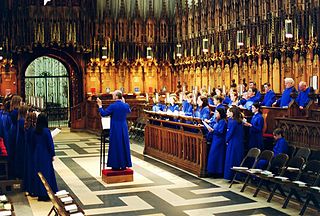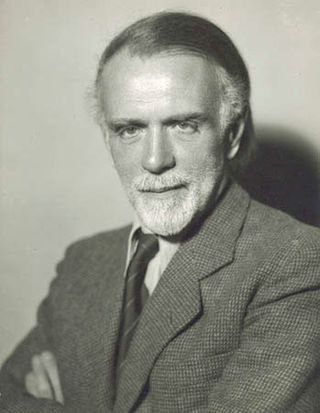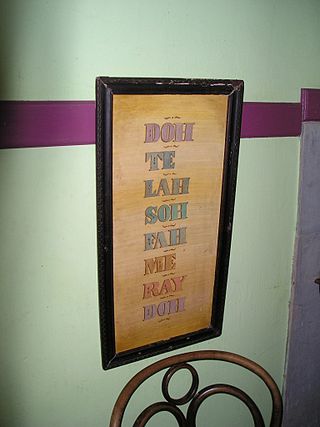Related Research Articles

A choir is a musical ensemble of singers. Choral music, in turn, is the music written specifically for such an ensemble to perform or in other words is the music performed by the ensemble. Choirs may perform music from the classical music repertoire, which spans from the medieval era to the present, or popular music repertoire. Most choirs are led by a conductor, who leads the performances with arm, hand, and facial gestures.
In music, solfège or solfeggio, also called sol-fa, solfa, solfeo, among many names, is a music education method used to teach aural skills, pitch and sight-reading of Western music. Solfège is a form of solmization, though the two terms are sometimes used interchangeably.

Zoltán Kodály was a Hungarian composer, ethnomusicologist, music pedagogue, linguist, and philosopher. He is well known internationally as the creator of the Kodály method of music education.

Conducting is the art of directing a musical performance, such as an orchestral or choral concert. It has been defined as "the art of directing the simultaneous performance of several players or singers by the use of gesture." The primary duties of the conductor are to interpret the score in a way that reflects the specific indications in that score, set the tempo, ensure correct entries by ensemble members, and "shape" the phrasing where appropriate. Conductors communicate with their musicians primarily through hand gestures, usually with the aid of a baton, and may use other gestures or signals such as facial expression and eye contact. A conductor usually supplements their direction with verbal instructions to their musicians in rehearsal.

Piacenza is a city and comune (municipality) in the Emilia-Romagna region of Northern Italy, and the capital of the eponymous province. As of 2022, Piacenza is the ninth largest city in the region by population, with more than 102,000 inhabitants.

Bobbio is a small town and comune in the province of Piacenza in Emilia-Romagna, northern Italy. It is located in the Trebbia River valley southwest of the town Piacenza. There is also an abbey and a diocese of the same name. Bobbio is the administrative center of the Unione Montana Valli Trebbia e Luretta. It is one of I Borghi più belli d'Italia.

The Duchy of Parma and Piacenza was an Italian state created in 1545 and located in northern Italy, in the current region of Emilia-Romagna.
Sigismondo d'India was an Italian composer of the late Renaissance and early Baroque eras. He was one of the most accomplished contemporaries of Monteverdi, and wrote music in many of the same forms as the more famous composer.

The Sistine Chapel Choir, as it is generally called in English, or officially the Coro della Cappella Musicale Pontificia Sistina in Italian, is the Pope's personal choir. It performs at papal functions in the Sistine Chapel and in any other church in Rome where the Pope is officiating, including St. Peter's Basilica. One of the oldest choirs in the world, it was constituted as the Pope's personal choir by Pope Sixtus IV. Although it was established in the late 15th century, its roots go back to the 4th century and the reign of Pope Sylvester I.

Maria Tecla Artemisia Montessori was an Italian physician and educator best known for her philosophy of education and her writing on scientific pedagogy. At an early age, Montessori enrolled in classes at an all-boys technical school, with hopes of becoming an engineer. She soon had a change of heart and began medical school at the Sapienza University of Rome, becoming one of the first women to attend medical school in Italy; she graduated with honors in 1896. Her educational method is in use today in many public and private schools globally.

Tonic sol-fa is a pedagogical technique for teaching sight-singing, invented by Sarah Ann Glover (1785–1867) of Norwich, England and popularised by John Curwen, who adapted it from a number of earlier musical systems. It uses a system of musical notation based on movable do solfège, whereby every note is given a name according to its relationship with other notes in the key: the usual staff notation is replaced with anglicized solfège syllables or their abbreviations. "Do" is chosen to be the tonic of whatever key is being used. The original solfège sequence started with "Ut", the first syllable of the hymn Ut queant laxis, which later became "Do".
Nicola Gomirato is an Italian artist involved in music, history and literature. He is an eclectic musician that writes, creates, and performs musical shows combining words, music, history, instruments and poetry.

Juguemos a Cantar, was a children's competition festival that was held yearly in Mexico City beginning in 1982. Televisa produced this show, and it was transmitted on the program, Siempre En Domingo, which was hosted by Raúl Velasco. This competition was developed to seek out young talent, and was open to all Mexican resident children up to the age of 13. Juguemos a Cantar was first and foremost a "Festival De La Canción", meaning that the songwriter and the song itself is celebrated along with the performer. All songs performed in the competition were required to be original, and the song writing is judged, as well as the artist performance. The popularity of its first transmission in 1982 made it one of the most important talent Festivals in all of Latin America. In the years it aired, it served to propel an impressive number of artists, such as: Lucero, Thalía, Edith Márquez, Eduardo Capetillo, and Lorenzo Antonio, as well as many songwriters, such as Omar Alfanno, Tirzo Paiz, Lorenzo Antonio, and Sergio Andrade.

Roberto Goitre was an Italian choirmaster, composer and teacher.

Italian ballet is the training methods and aesthetic qualities seen in classical ballet in Italy. Ballet has a long history in Italy, and it is widely believed that the earliest predecessor of modern-day ballet originated in the Italian courts of the Renaissance. Two predominant training systems are used to teach Italian ballet today: the Cecchetti method, devised by Enrico Cecchetti, and that of the La Scala Theatre Ballet School.

John Franklin Botume was a singer, choir director and vocal pedagogist. He is the author of several books on singing including Modern Singing Methods: Their Use and Abuse (1885).

Alberto Zedda was an Italian conductor and musicologist whose specialty was the 19th-century Italian repertoire.

The Conservatorio Statale di Musica "Gioachino Rossini" is a music conservatory in Pesaro, Italy. Founded in 1869 with a legacy from the composer Gioachino Rossini, the conservatory officially opened in 1882 with 67 students and was then known as the Liceo musicale Rossini. By 2010 it had an enrollment of approximately 850 students studying for higher diplomas in singing, instrumental performance, composition, musicology, choral conducting, jazz or electronic music. The conservatory also trains music teachers for secondary schools and holds regular master classes. Its seat is the 18th century Palazzo Olivieri–Machirelli on the Piazza Oliveri in Pesaro. Amongst its past Directors are the composers Carlo Pedrotti, Pietro Mascagni, Riccardo Zandonai and Franco Alfano. Mascagni's opera Zanetto had its world premiere at the conservatory in 1896.
Hanus Aldo Schimmerling (1900–1967), pianist, composer, teacher, musicologist, and writer, known professionally as Hanns Aldo Schimmerling, was born to Hugo Schimmerling, a dentist, and Eugenie (Jennie) Grossman in Brno, the capital of Moravia in the Czech Republic. Both parents, in their sixties, fell victims to the Holocaust in 1944.
The Coro Polifonico Farnesiano is a choir based in Piacenza, Italy. It was founded in 1976 by Roberto Goitre, and since the aforementioned choirmaster's death in 1980, has been conducted by Mario Pigazzini.
References
- ↑ "In Cattedrale, canti natalizi dal XIII secolo a oggi", La Nazione (in Italian), Poligrafici Editoriale, retrieved 30 April 2011